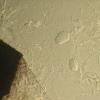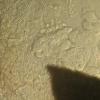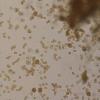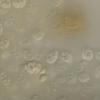
21-12-2025 21:32
Pol DebaenstHello, Garden, Burgweg 19, Veurne, BelgiumOn 10/1

22-12-2025 23:38
Patrice TANCHAUDBonsoir, récolte sur un mur en pierre, apothéci

21-12-2025 09:32
Hello.A tiny ascomycete found embedded in wood in

22-12-2025 00:47
Patrice TANCHAUDBonsoir, récolte à proximité du milieu dunaire

21-12-2025 21:40
Isabelle CharissouBonjour, j'aimerais connaitre les références de

21-12-2025 21:31
Pol DebaenstHello, Garden, Burgweg 19, Veurne, BelgiumOn 10/1

21-12-2025 21:31
Pol DebaenstHello, Garden, Burgweg 19, Veurne, BelgiumOn 10/1

20-12-2025 23:08
Patrice TANCHAUDBonsoir, récolte sur sol sablonneux dans l'arri�
Can someone help to identify this fungus? I have no idea how to start with anamorphic fungi so I just included some pictures. Oh, I have more then enough material to provide data necessary for identification. They look like normal sexual pyrenomycetes. They were growing on Laetiporus sulphureus which I stored in a cooling room for several months now (for my research).
Cheers!

This looks to me like an immature ascomycete. The chain-like cells may be the sort of paraphyses produced by species of the Microascaceae or Melanospora. If it developed so well in your cooling room, maybe you should just give it time to mature there.
Dave

I have attached a copy of my paper on Microascus caviariformis, which illustrates the chain-like paraphyses typical of the family.

Dieter

I apologize for not replying to your message in May. I was away on holiday and did not have access to the internet.
Your collection is definitely a species of Microascus. The ascospores resemble those of M. longirostris, a species found in a variety of habitats. Microascus longirostris has quite small ascospores, only about 3-4 X 2.5 µm, so if yours are larger it is probably some other species. Precise identification requires studying pure cultures, mainly because the anamorphs are important. These may be Scopulariopsis, Cephalotrichum (Doratomyces), Trichurus, Wardomyces and perhaps others. If you have access to Petri dishes and culture media you could probably still germinate the ascospores.
There is a key to species in Arx, J.A.,M.J.Figueras and J.Guarro: Sordariaceous Ascomycetes without Ascospore Ejaculation. 1988. Nova Hedwigia Beiheft 94, but I do not have a pdf to send you. An older paper by Barron in Canadian Journal of Botany 39: 1609-1631 (1961) has good illustrations and a key to species.
I hope this helps.
Dave
Thanks!
Dieter

Making a culture of your Microascus is possible but perhaps difficult. We have fairly good results growing these on DPYA (dextrose-peptone-yeast agar). I have included a formula for this on my web site at http://website.nbm-mnb.ca/mycologywebpages/Moulds/Cultivation.html. Most Microascaceae grow well when the carbon/nitrogen ratio is fairly low as in DPYA. The antibiotics, oxgall and sodium propionate help to control contaminants when making isolations from field material. If you cannot get all of these just use the ones you have . After you obtain a pure culture you can grow it on DPYA without the inhibitors. Keep the incubation temperature low; 10-18° C if possible; this will help to keep Trichoderma from destroying your culture.
To make the isolation you must clean the surface of a perithecium without breaking its peridium. I do this by gently pushing one prithecium over and through the agar medium until it seems to be entirely clean. Use a dissecting microscope for this operation. When it is quite clean transfer the perithecium to a new dish and break its peridium to release the ascospores. When the spores come out, transfer them to another part of the plate and spread them out over the agar surface. If they are still alive they should germinate within 1-3 days.
Good luck!
Dave
Hi Dave,
Sorry for not replying on this but at that time I did not had time to go deeper into this. Recently I found these fruitbodies again on Laetiporus!!! These should be the asci I suppose? I will try to follow up these fruitbodies. :)
Dieter

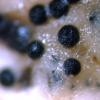

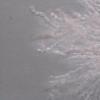
 Malloch & Hubart-Microascus
Malloch & Hubart-Microascus